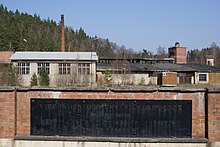Silberhütte (Harzgerode)
|
Silver hut
Harzgerode city
Coordinates: 51 ° 37 ′ 40 ″ N , 11 ° 5 ′ 29 ″ E
|
|
|---|---|
| Height : | 340 (339-384) m |
| Incorporation : | August 1, 2009 |
| Postal code : | 06493 |
| Area code : | 039484 |
Silberhütte is a district of Harzgerode in the Harz district in Saxony-Anhalt .
geography
Silberhütte is located in the Lower Harz in the Selketal .
history
Silberhütte was first mentioned in a document in 1693, which is also the year the place was founded. There was already a silver smelter at this location , mentioned in 1440, a potash hut and several stamping mills . The ore extracted from the surrounding mines was processed in these. The artificial moat (from 1904: Silberhütter Kunstgraben ) built to supply water to the hut later called Victor-Friedrich-Silberhütte is the longest in the Lower Harz pond and moat system with 25.5 km . The silver smelter, which was built in 1693, has been expanded several times over the course of over two centuries with new operations. The silver yield reached peak values in 1898 with 17.62 t and lead extraction in 1902 with 2871 t. In the end, a lithopone , a sulfuric acid and a chemical factory, as well as a cement factory, worked next to and closely connected to the silver smelter . Before that, there was also a sulfur and vitriol factory , a glassworks and a soap factory . After privatization, multiple changes of ownership, temporary use of foreign ore and exhaustion of the Neudorf mines, operations had to be closed after bankruptcy in 1909. In 1910, the hut and the attached works were demolished.
The largest company in Silberhütte with 190 employees was the “powder mill”, which was already part of the allodial goods of Prince Friedrich von Anhalt-Harzgerode , who died in 1709 . In 1790, Prince Alexius Friedrich Christian von Anhalt-Bernburg granted the owner the privilege to build a powder mill for the production of black powder, ignition powder and hunting powder. From 1893 the production of fireworks was also started. During the First World War, the factory worked for military needs. A decade later, Max Valier found the necessary prerequisites for experiments with rocket-powered rail vehicles in the company JF Eisfeld, Pulver- und Pyrotechnische Werke . The "Eisfeld-Valier-Rocket 2" reached a speed of 253 km / h - a world record at the time.
The most important location for the wood industry in the Lower Harz Mountains had developed on the site of the former silver smelter. The Silberhütte settlement had gradually become a place with a village infrastructure. The village church was built entirely from spruce wood in 1932.
After 1933, the activity of the pyrotechnic company was dominated by arms production. With a few hundred prisoners of war, the number of employees grew to around 700. After the war, partially dismantled, the factory as VEB Pyrotechnik Silberhütte achieved a remarkable boom with 850 employees at last. Including VEB Holzwerke Rinkemühle, there were around 1200 industrial jobs in Silberhütte in 1989. The population grew to almost 300.
While the wood industry had to be given up under the economic conditions of reunified Germany in the mid-1990s, pyrotechnics, which was also privatized in 1990, became part of Rheinmetall Waffen Munition GmbH in 2004 with around 250 employees in the Silberhütte branch. At the end of 2016, 154 permanent residents were still living in the Harzgerode district of Silberhütte.
Waters
In the vicinity of the train station, the Pulverbach , which flows completely within the Silberhütte district, flows into the Selke , on the banks of which the village was built. In addition, two of the ponds of the Lower Harz pond and ditch system are located in the vicinity of Silberhütte - the Teufelsteich and the Fürstenteich .
Attractions
In addition to the Silberhütte forest church, there is the Unterharzer Waldhof in Silberhütte , an adventure and exhibition complex about forestry . This is located on the site of the former wood processing company - in turn built on the former steel mill site. The Waldhoffest takes place annually with log pulling.
The monuments located in Silberhütte are listed in the local register of monuments.
traffic
Silberhütte has had a train station on the Selketalbahn since 1889 . Silberhütte is connected to Harzgerode and Güntersberge by a bus line operated by the Harzer Verkehrsbetriebe . State road 234 runs through the village . From here you can also hike the nearby old mining ponds on various hiking trails.
literature
- Heinz Schnitzer: Three hundred years of silver works. In: Harzgeroder Hefte 2, 1993.
- Karl-Heinz Börner : Silberhütte - a traditional industrial location in the Selketal. In: General Harz Mountain Calendar for the year 2000. 1999.
- Elmar Hebestedt: On the history of the Anhalt Victor Friedrichs Silberhütte. In: The Anhalt Harz as a cultural area. Contributions to the regional and state culture of Saxony-Anhalt. H. 58, 2014, ISBN 978-3-940744-57-9 .
- Author collective: 225 years of pyrotechnics in Silberhütte. 2015.




